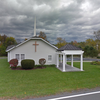Hamlet plan outlines changes to calm traffic
GUILDERLAND CENTER Martha Whitney is tired of truck traffic shaking the walls of her house.
“When the big trucks roll by, my pictures get tilted, and sometimes my knick-knacks fall off the shelf,” she said. Whitney, who has lived on Route 146 in Guilderland Center for 30 years, served on an advisory committee that helped draft a master plan for the hamlet.
The plan was accepted by the town board Tuesday after nearly a year of advisory committee meetings and public workshops. It had been recommended by the town’s comprehensive plan, drafted in 2001.
The hamlet plan recommends solutions for heavy traffic ranging from traffic-calming devices, to a roundabout, which may not be able to get funding. The plan also outlines sidewalks to be built with a grant of $681,000, already in-hand.
Whitney summed the study process up by saying, “It’s a wonderful plan, with a great vision, but I hope we can tend to the immediate needs first sidewalks and speed reduction. After all, that’s what got our panties in a bunch in the first place!”
The small hamlet of Guilderland Center straddles Route 146, with houses, many of them more than a century old, close to the road. In addition to the school district’s bus garage and high school, Guilderland Center has the town’s transfer station and highway garage, a strip mall and an apartment complex, as well as a nursing home and a large industrial park.
In two public workshops held last spring and fall, roughly 100 residents turned out to voice their concerns, primarily about traffic safety and pedestrian connections. The workshops were hosted by Michael Welti, a consultant hired by the town; he’s the director of planning services for Behan Planning and Design.
“It was very rewarding for us to know there is an interested public,” Welti told the town board. In addition to hosting the public workshops, Welti periodically met with a study advisory committee, comprised of residents, members of the town planning board, the town’s grant writer, and representatives of the Albany County Department of Public Works, the state’s Department of Transportation, and the Capital District Transportation Committee.
There are several categories of recommendations included in the plan transportation, traffic speed, pedestrian environment, intersection improvements, and parks and recreation. The plan is available online at www.townofguilderland.org or at the town hall.
Traffic solutions
Many residents at the public workshops expressed their displeasure with the number of trucks and buses traveling through the center of the hamlet on Route 146.
Most of the trucks are going to the Northeastern Industrial Park, with an entryway Van Buren Road in Guilderland Center.
One of the master plan’s recommendations to relieve truck traffic is to re-open the Depot Road gate to the industrial park, which was closed several years ago when the Van Buren Road entrance was created. If the Depot Road gate were to re-open, trucks would be able to enter and leave the park, while bypassing the center of the hamlet completely.
Welti said on Tuesday that he had met with the owners of the Northeastern Industrial Park while drafting the master plan.
“I can’t say that they definitely want to open the Depot Road gate at this time, but it’s not out of the question,” said Welti. He said the industrial park would need to consider some security issues for the second gate, and that the town, after adopting the master plan, would have to discuss the matter with the owners of the park.
School buses also concern residents. The Guilderland Central School District bus depot is located in Guilderland Center, and most of the district’s 116 buses travel through the hamlet several times during the day. The master plan recommends re-routing the eastbound school buses onto Van Buren Road so they could enter the bus depot from the rear. An entrance would need to be created just outside the gate to the industrial park, which would require the collaboration of the town, the school district, and the owners of the park. Welti said the town had already been in discussions with the school district about this matter.
Multiple recommendations for “traffic-calming” on Route 146 are included in the master plan. The most effective solution would be to request a reduced speed limit, but, since Route 146 is a state highway, the DOT has jurisdiction, and would need to approve and enforce a reduced limit.
Susan Weeks, another resident advisory committee member, has lived on Route 146, in the same house, since 1969. She said she has contacted the DOT a number of times over the past 40 years with concerns about the speed limit, without getting any results.
“I don’t know how amenable any of these organizations and committees will be now that the town has adopted the master plan. They certainly haven’t been in the past,” said Weeks.
Other potential traffic-calming techniques outlined in the plan include the installation of center medians, textured pavements, raised crosswalks, narrow lane widths, paint striping, and streetscape elements.
“Though the speed limit on Route 146 drops to 40 miles-per-hour in the hamlet, the roadway itself does not really change. As a result, drivers do not receive any signal (other than the speed limit sign) that indicates that they should slow down. By installing appropriate traffic calming techniques such as raised medians at the gateways to the hamlet, motorists will be forced to slow down and recognize that the hamlet environment is different than the rural highway environment,” the master plan reads.
There are five intersections targeted in the master plan Route 146 and School Road, School Road and Depot Road, Route 146 and French’s Mill Road, Route 146 and Van Buren Road, and Route 146 and Depot Road.
Route 146 and School Road is the main intersection in Guilderland Center, and is recognized as the intersection in need of the most attention. It experiences a lot of congestion, especially during the morning and afternoon when there is school traffic. Both the bus facility and the high school are located off of School Road. Three potential recommendations in the plan are to add left-turn lanes in both the westbound and eastbound directions, a one-lane roundabout, and the addition of pedestrian and streetscape enhancements.
“The analysis indicates that the roundabout is the best operational alternative,” states the master plan. A roundabout could decrease the overall traffic delay by 13 seconds in the morning, nine seconds midday, and three seconds in the evening.
“We were only able to do this study on a broad level, working with aerial photos and parcel data, not survey mapping,” Welti said. He said the town would have to partner with the DOT to study the intersections in more detail before acting on a solution. A roundabout would be the most expensive option, ranging from $1 million to $1.5 million for construction, but, Welti said, it would be more likely to qualify for federal funding than other alternatives.
“In general, speaking for only the residents, we’re not in favor of the construction of a roundabout in this tiny hamlet,” said Weeks. She said the residents would much prefer to see a speed-limit reduction. A single-lane roundabout is also recommended for the intersection of School Road and Depot Road, along with the alternative solution of making that intersection an all-way stop.
Sidewalks ahead
The second most pressing concern for residents, highlighted at both public workshops, was sidewalks. According to the master plan, the ultimate goal is to install sidewalks on both sides of Route 146 and School Road. Due to a lack of resources, the plan calls for the installation to occur in phases.
A $681,000 grant for sidewalk construction on Route 146 has been secured through the CDTC’s Transportation Improvement Program. The master plan recommends using the money for installing sidewalks on the south side of Route 146 from Depot Road to French’s Mill Road.
“With the money already allocated, there will be something in the not-too-distant future for hamlet residents to see,” said Welti. As far as future implementations, the study acknowledges that local and state fiscal resources are constrained, and it could take time to accomplish many of the goals set.
Immediate and short-term actions, aside from the sidewalk implementation, are starting discussions among the town, the school district, and the Northeastern Industrial Park, seeking funding for a second phase of sidewalk construction, and researching improved pedestrian connections.
Long-term actions involve researching funding opportunities. The master plan indicates a variety of potential funding sources, including federal funds through the CDTC, Transportation Improvement Funds, state funds from the DOT, and grant programs.
The plan also recommends that, within the next three to five years, the town board or the town planning department should hold a public meeting with hamlet residents to review progress on the recommendations.


